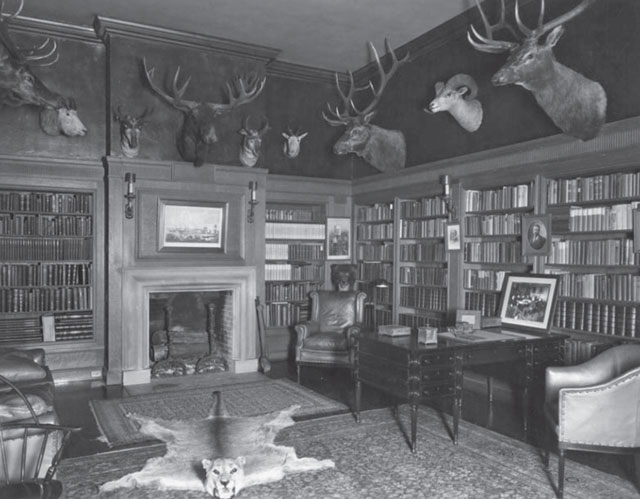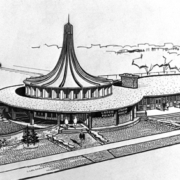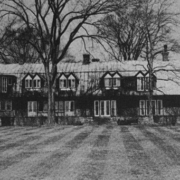Historical Architecture of Grosse Pointe – Henry Shelden
Last week we explored the history of 1008 Buckingham, a magnificent home designed by Louis Kamper. It was completed in 1921-1922 for Kurt Kling, a prominent figure in Detroit and the P. H. Kling Brewing Company.
Over the past few weeks, we have presented the history of several prominent figures and the grand estates they commissioned, including William Crowley, Herbert V. Book, and Kurt Kling. This week we continue the theme as we explore the home of Henry Shelden and his stunning “Deeplands” property, razed in 1947.
Henry Dusenbury Shelden was a Detroit industrialist who was born in Portville, N.Y on 17 June 1862. He attended Yale College, where he studied law. Upon graduation he was admitted to the Michigan bar in 1887. That same year he married Caroline A. Alger, daughter of Russell Alexander Alger Sr., the former Governor of Michigan, and Secretary of War in President McKinley’s cabinet. Caroline born on 20 January 1865, was a member of many prominent societies in and around Detroit including the Society of Arts and Crafts, Daughters of the American Revolution, and the Detroit Museum of Art’s Founders Society. Henry and Caroline had four children: Allan, Annette, Alger, and Henry Jr. Image courtesy of: familysearch.org

Between 1887 and 1890, Henry Shelden was involved in the wholesale dry goods business. Then, after 1890, he devoted his attention to serving on various corporate boards such as – the Detroit Copper and Brass Rolling Mills, Fort Street Union Depot and Station Co., and Alger, Smith & Co. Mr. Shelden was also an astute real estate investor. His three sons followed in their fathers’ footsteps, when, in 1919, they formed Shelden Sons, a Detroit real estate firm. It was reported “the Shelden’s worked together in the New Penobscot Building and the Buhl Building in the 1920s. Together, they incorporated several real estate and development firms in Michigan between 1924 and 1925, including the Shelden Construction Co., and established the real estate development firm, the Shelden Land Company”. Source: Oldrosedalegardens.com
Between 1910 – 1911 Henry and Caroline Shelden’s “Deeplands” estate was completed. Located at 525 Lake Shore, it was designed by a noted architect from Chicago, Arthur Heun. It is possible the estate was Heun’s only project in Metro Detroit., The stunning Italian Villa was located on an incredible piece of land, on the shores of Lake St. Clair. It is believed the lot was part of the former George S. Davis estate. Based on research by the Grosse Pointe Historical Society, we understand “George S. Davis for some years had owned a summer home on what he called the “Claireview Jersey Stock Farm.” The huge Davis property ran from the lake all the way back to Mack Avenue. Once the land was subdivided, it became the location for numerous large estates including “Deeplands” (525 Lake Shore); “Clairview” (575 Lake Shore); and “Fairholme” (585 Lake Shore). Image courtesy of Wayne State University Digital Collection (1933) – Deeplands is marked by the red frame. It is reported the remainder of the George S. Davis estate was purchased by J. L Hudson, also around 1910 – 1911. mage courtesy of Wayne State University Digital Collection (1933) – Deeplands is marked by the red frame; and Grosse Pointe Historical Society.



Deeplands was set on 80-acres. Not only did have 1,200 sq ft of water frontage, but it also went back about a mile and a half deep into the woods. Given how far the home was located from the lake this allegedly led to its name ‘Deeplands’. The front of the home faced Lake Shore, while the entrance was at the rear, nestled within an abundance of trees and shrubs. Aside from the house the estate also included three smaller buildings – a four-car garage, stables, and a residence for the gardener. Images are courtesy of: Grosse Pointe Historical Society.



The “long, low, rambling mansion” was constructed from stone that had a distinctive yellow hue, while the roof was green tile. Based on an article in the Detroit Free Press (January 1914) we understand the interior of the home was stunning, with no expense spared in creating a luxurious interior for the family. The main corridor, leading from the foyer had gleaming marble pillars. Accessed from the main corridor was the library and the music room. The “artistic” music room had pale grey walls and was styled in a Louis XVI period approach. The long living room had a color scheme of bronze with yellow tints, while a life-sized painting hung at one end of the room. The library displayed a collection of family portraits as well as several mounted hunting trophies. The house was decorated throughout with furniture, paintings, and heirlooms that had once adorned Mrs. Shelden’s childhood home in Detroit, the Governor Alger Mansion. The extravagant furnishings and décor created a fashionable showplace for the Shelden’s many lavish parties that included a visit from Duke Alexander of Russia, (cousin of the late Czar Nicholas II), who spoke at the second assembly of the Detroit Salon of Fine Arts. Source: Detroit Free Press, November 3, 1929.
On 12 August 1935, Caroline Shelden passed. Six years later, on 7 December 1941, Henry Shelden died at his beloved home. Source: portvillehistory.org. In 1942, shortly after her father’s death, Annette Shelden Stackpole and her husband Stephen T. Stackpole (an official of the Pennsylvania Railroad whose office was in Detroit) moved into their new home, “The Hedges” located at 521 Lake Shore (it would later be given a new address of 55 S Deeplands). The more modest sized Georgian Colonial style mansion, set on 8 acres, was designed by another noted Chicago designer, Robert Work. The couple resided in the home with their son, Stephen M. Stackpole.


In 1947, following the deaths of Henry and Caroline Shelden, “Deeplands” was razed. The land was subsequently sub-divided and the former 80-acre estate became known as the Deeplands Subdivision. Meanwhile, it appears Stephen M. Stackpole lived his entire life at 55 South Deeplands, the property where he was born, until he passed on 31 January 2014. It was razed around 2017.
In the proceeding years over 80 homes have been built on the original “Deeplands” lot. The land where 55 South Deeplands was located has also been subdivided. Two streets have been named after the original estate – N. Deeplands and S. Deeplands, while Shelden Lane immortalizes this once prominent family.
* Photos courtesy of the Higbie Maxon Agney archives unless stated.
** Research, information, and data sources are deemed reliable, but accuracy cannot be fully guaranteed.
Written by Katie Doelle
Copyright © 2024 Katie Doelle









